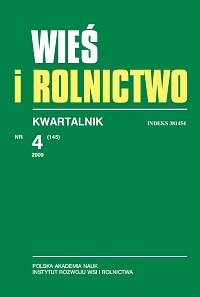Kształtowanie się nowej struktury własnościowej i prawno-organizacyjnej producentów rolnych w Rosji
The Emergence of a New Ownership and Legal-Organisational Structure of Agricultural Producers in Russia
Author(s): Włodzimierz DzunSubject(s): Economy
Published by: Instytut Rozwoju Wsi i Rolnictwa Polskiej Akademii Nauk
Keywords: agricultural reform; de-collectivisation of agriculture; restructuring of kolkhozes and sovkhozes; legal-organisational structure of agricultural producers; agricultural enterprises; private farms; household crofts; structure of utilisation of arable land
Summary/Abstract: The democratic and market reforms inaugurated in Russia in the early 1990s marked also the beginning of a spontaneous process shaping a new legal-organisational structure of agricultural producers. The basis for the start of this process was the agricultural reform (de-collectivisation of agriculture) providing for the apportionment of arable land to the farm workers by means of the so-called stakes (some 12 million persons) and for the restructuring of kolkhozes and sovkhozes. The principal tendencies that characterise this process are: firstly, the formation – chiefly on the basis of the former kolkhozes and sovkhozes, of a new organisational-legal structure of agricultural enterprises based on private ownership, secondly, the emergence and development of a new group of agricultural producers (farmers) and, thirdly, the strengthening of an extremely large group of household crofts which have a very long tradition in Russian agriculture. The process is reflected also in the changing structure of land and labour resources and, consequently, in the structure of agricultural production which changes under the influence of the emerging forms of husbandry. The principal tendency in this process is growth in the number of private farms and household crofts and a decline in the number of agricultural enterprises. Demokratyczno-rynkowe przemiany, jakie rozpoczęły się w Rosji na początku lat dziewięćdziesiątych ubiegłego wieku, zapoczątkowały także żywiołowy proces kształtowania się nowej struktury organizacyjno-prawnej producentów rolnych. Podstawą tego procesu była reforma rolna (dekolektywizacja rolnictwa), zakładająca nadzielenie ziemią rolną pracowników poprzez tzw. udziały (około 12 mln osób) oraz restrukturyzację kołchozów i sowchozów. Podstawowe tendencje w tym procesie to: po pierwsze formowanie się, głównie na bazie byłych kołchozów i sowchozów nowej struktury organizacyjno-prawnej przedsiębiorstw rolnych opartej na własności prywatnej, po drugie powstanie i rozwój nowej grupy producentów rolnych, jakimi są gospodarstwa chłopskie (farmerskie), i po trzecie umocnienie się, mającej długą tradycję w rolnictwie rosyjskim, ogromnej grupy gospodarstw przydomowych. Proces ten ma swoje odzwierciedlenie w zmianach struktury zasobów ziemi i zasobów pracy, a w konsekwencji – struktury produkcji rolnej według kształtujących się form gospodarowania. Podstawowa tendencja w tym procesie to zwiększenie liczby gospodarstw chłopskich (farmerskich) i przydomowych, a zmniejszenie liczby przedsiębiorstw rolnych.
Journal: Wieś i Rolnictwo
- Issue Year: 145/2009
- Issue No: 4
- Page Range: 67-82
- Page Count: 16
- Language: Polish

